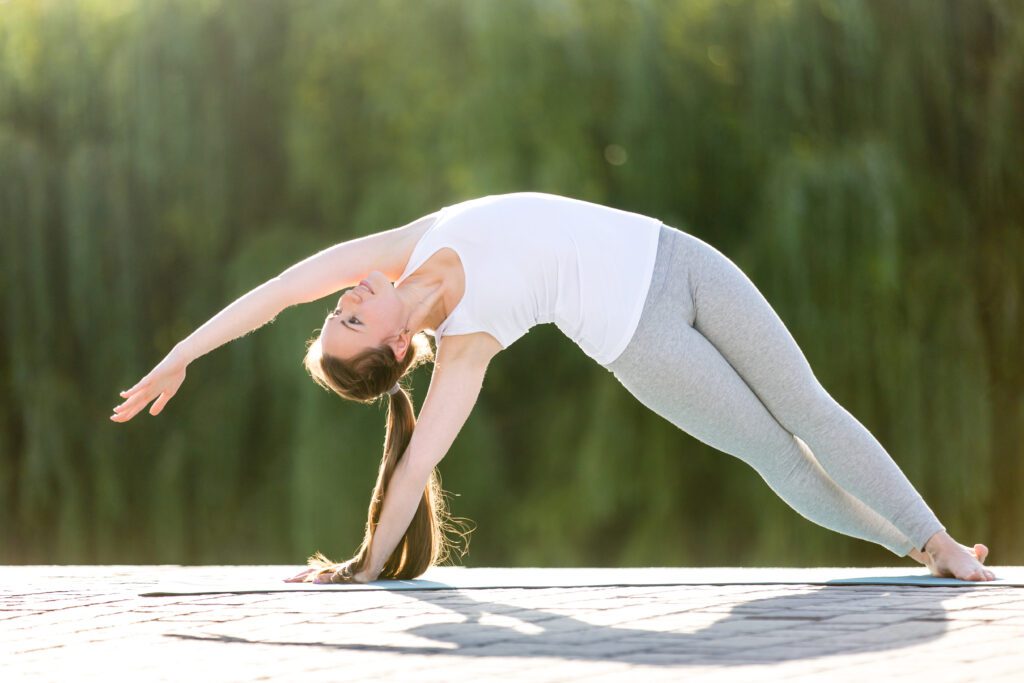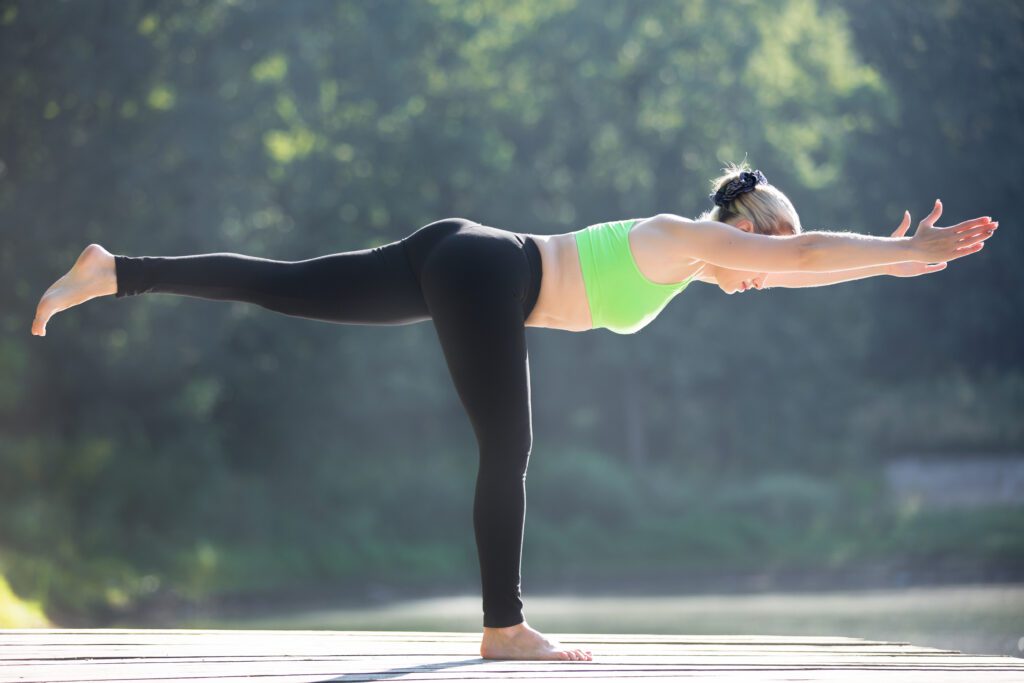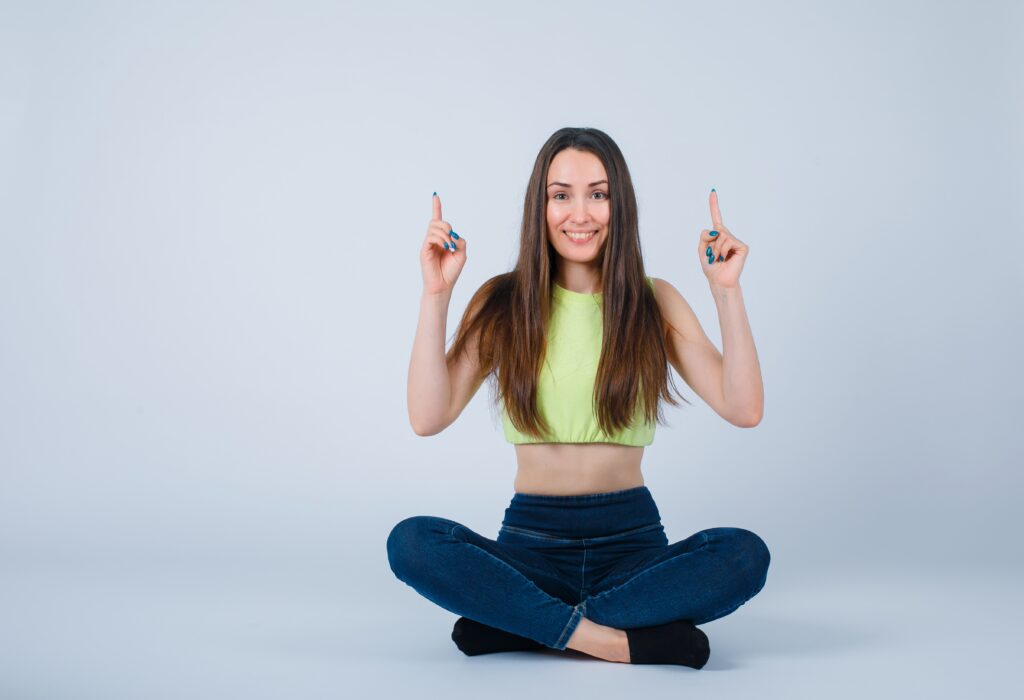Table of Contents
ToggleVinyasa yoga is a dynamic and flowing style of yoga that emphasizes the connection between breath and movement. It is one of the most popular styles of yoga, known for its fluid sequences and creative transitions. The word “vinyasa” can be translated as “arranging something in a special way,” and in the context of yoga, it refers to the synchronization of breath and movement.
Features Of Vinyasa Yoga

-
Breath-Centered Movement:
Vinyasa yoga places a strong emphasis on linking breath with movement. Each movement is coordinated with either an inhalation or exhalation, creating a continuous flow.
-
Flowing Sequences:
Classes are typically composed of a series of flowing postures that seamlessly transition from one to the next. The transitions are as important as the poses themselves.
-
Sun Salutations:
Sun Salutations, or “Surya Namaskar,” are often a fundamental component of Vinyasa classes. These sequences involve a series of postures performed in a flowing, rhythmic manner.
-
Variety of Poses:
Vinyasa classes can include a wide range of yoga poses, including standing, seated, balancing, and inverted poses. The variety keeps the practice engaging and challenging.
-
Creative Sequencing:
Instructors have the flexibility to create unique and creative sequences, making each class different. This allows for both variety and progression in the practice.
-
Breath Awareness:
Practitioners are encouraged to stay connected to their breath throughout the practice. Conscious breathing not only helps in maintaining the flow but also enhances mindfulness.
-
Strength and Flexibility:
Vinyasa yoga can help build strength, flexibility, and endurance. The continuous movement and engagement of various muscle groups contribute to overall physical fitness.
-
Mind-Body Connection:
The focus on breath and movement fosters a deep connection between the mind and body. Vinyasa yoga is not just a physical workout; it also has meditative and mindfulness components.
-
Adaptability:
Vinyasa classes can be adapted to different levels, making it accessible to beginners while providing challenges for more experienced practitioners. Modifications can be offered to accommodate varying abilities.
-
Warm-Up and Cool-Down:
Classes typically begin with a warm-up to prepare the body for movement and end with a cool-down to promote relaxation and recovery.
-
Inversion and Arm Balance Options:
Vinyasa yoga often includes opportunities for inversions (such as headstands or handstands) and arm balances. These poses add an element of challenge and playfulness to the practice.
Vinyasa yoga offers a dynamic and invigorating experience, making it a popular choice for those seeking a combination of physical exercise, mindfulness, and creative expression in their yoga practice. Classes may vary in intensity and pace, so individuals can find a Vinyasa class that suits their preferences and fitness level.
Benefits Of Vinyasa Yoga

Vinyasa yoga offers a variety of physical, mental, and emotional benefits. The dynamic and flowing nature of Vinyasa practice, combined with the synchronization of breath and movement, contributes to a holistic and invigorating experience. Here are some of the benefits of practicing Vinyasa yoga:
-
Cardiovascular Health:
The continuous and rhythmic flow of Vinyasa sequences can elevate the heart rate, providing cardiovascular benefits and improving overall heart health.
-
Increased Strength and Flexibility:
Vinyasa yoga engages various muscle groups, helping to build strength and enhance flexibility. Regular practice can lead to improved muscle tone and range of motion.
-
Mind-Body Connection:
The focus on breath and movement promotes a strong mind-body connection. Practitioners become more aware of their bodies and breath patterns, fostering mindfulness.
-
Stress Reduction:
The rhythmic breathing and flowing sequences of Vinyasa yoga can induce a state of relaxation, reducing stress and promoting mental well-being.
-
Improved Balance and Coordination:
Balancing poses and transitions in Vinyasa sequences enhance proprioception and coordination, contributing to improved overall balance.
-
Enhanced Concentration:
The need to stay present and focused on the breath and movement in Vinyasa yoga can enhance concentration and mental clarity.
-
Calorie Burn:
The dynamic nature of Vinyasa yoga, especially in more vigorous classes, can contribute to calorie burn and weight management.
-
Detoxification:
The emphasis on deep, conscious breathing and movement may support the body’s natural detoxification processes by encouraging the release of toxins through breath and sweat.
-
Creativity and Self-Expression:
Vinyasa yoga often allows for creative and varied sequencing. Practitioners can express themselves through movement, fostering a sense of creativity and individuality.
-
Increased Energy:
Many people experience a boost in energy levels after a Vinyasa yoga practice, as the combination of breath and movement can invigorate the body and mind.
-
Enhanced Respiratory Function:
The focus on intentional breathwork in Vinyasa yoga can improve lung capacity and respiratory function over time.
-
Community and Social Connection:
Vinyasa classes often create a sense of community as practitioners move through the sequences together. This social connection can contribute to a positive and supportive environment.
Emotional Well-being:
Regular Vinyasa practice can have a positive impact on emotional well-being by reducing symptoms of anxiety and depression and promoting a more positive outlook on life.
Conclusion
Vinyasa yoga offers a dynamic and streaming practice that synchronizes breath with development, making an agreeable association of brain, body, and soul. Through its accentuation on liquid changes, imaginative groupings, and careful mindfulness, Vinyasa yoga gives an extraordinary encounter that supports actual strength, adaptability, and equilibrium while advancing mental clearness, stress help, and profound prosperity.
The act of Vinyasa yoga urges specialists to investigate their edge, develop internal strength, and embrace the current second with transparency and acknowledgment. Whether you’re a novice or an accomplished yogi, Vinyasa yoga offers a flexible and versatile practice that can be custom fitted to suit individual requirements and objectives.
By incorporating breathwork, contemplation, and asana (actual stances), Vinyasa yoga encourages a profound feeling of association with oneself and the encompassing scene, cultivating a feeling of inward harmony, imperativeness, and strength. Eventually, the excellence of Vinyasa yoga lies in its capacity to engage people on their excursion of self-disclosure, development, and all encompassing prosperity.
Frequently Asked Questions About Vinyasa Yoga

-
What is Vinyasa flow yoga?
Vinyasa flow yoga is a dynamic style of yoga that links breath with movement in a flowing sequence of poses. It emphasizes smooth transitions and creative sequences to build strength, flexibility, and mindfulness.
-
Is Vinyasa yoga more intense than power yoga?
Vinyasa yoga and power yoga can both be extraordinary, but power yoga typically focuses more on strength and endurance, while Vinyasa emphasizes fluidity and breath awareness.
-
Is Vinyasa yoga ok for beginners?
Indeed, Vinyasa yoga can be appropriate for beginners , yet it’s essential to start with beginner-friendly classes and adjust Poses like expected to match your ability level.
-
Is Vinyasa yoga difficult?
Vinyasa yoga can be challenging because of the consistent flow and transitions between poses ,however with training and persistence, it turns out to be more open and fulfilling.
-
Is Vinyasa yoga harder than Hatha?
Vinyasa yoga is often more physically demanding and involves more movement than traditional Hatha yoga, which focuses on holding poses for longer periods.
-
What is Vinyasa yoga and its benefits?
Vinyasa yoga combines breath and movement to improve strength, flexibility, balance, and mental focus. It promotes stress reduction, mindfulness, and overall well-being.
-
What is the difference between Ashtanga and Vinyasa yoga?
Ashtanga yoga follows a specific sequence of poses and is more structured, while Vinyasa yoga is more fluid and allows for creative sequencing and variations.
-
What does Vinyasa yoga do for your body?
Strengthen Muscles
Improve Flexibility
Enhance Balance and Cordination
Promote Relaxation
Improve Posture
Support Weight Management
Boost Energy Level
-
How should you do Vinyasa yoga effectively?
Practice Regularly
Listen To Your Body
Focus On Your Breath
Modify Poses as Needed
Stay Present In Each Moment
-
Why does everyone need Vinyasa yoga?
Vinyasa yoga offers a holistic approach to fitness and well-being, combining physical exercise, breathwork, mindfulness, and relaxation, making it beneficial for people of all ages and fitness levels.
-
Which book is the best to learn Ashtanga and Vinyasa yoga flow?
Some popular books for learning Ashtanga and Vinyasa yoga include “The Power of Ashtanga Yoga” by Kino MacGregor and “The Heart of Yoga” by T.K.V. Desikachar. It’s also helpful to complement book learning with practical classes or workshops.
